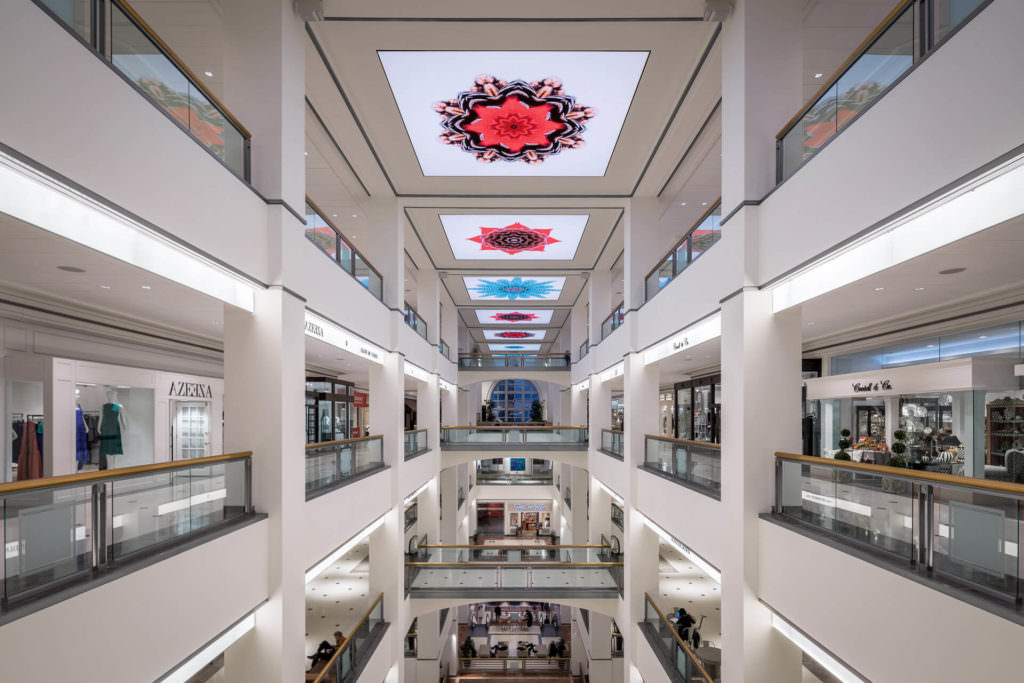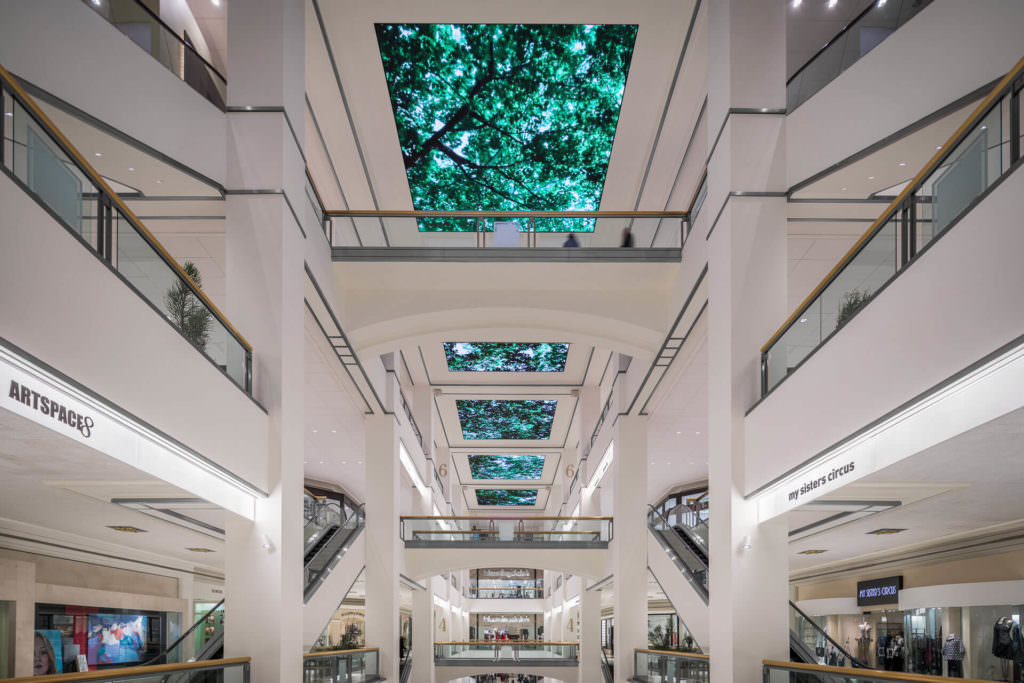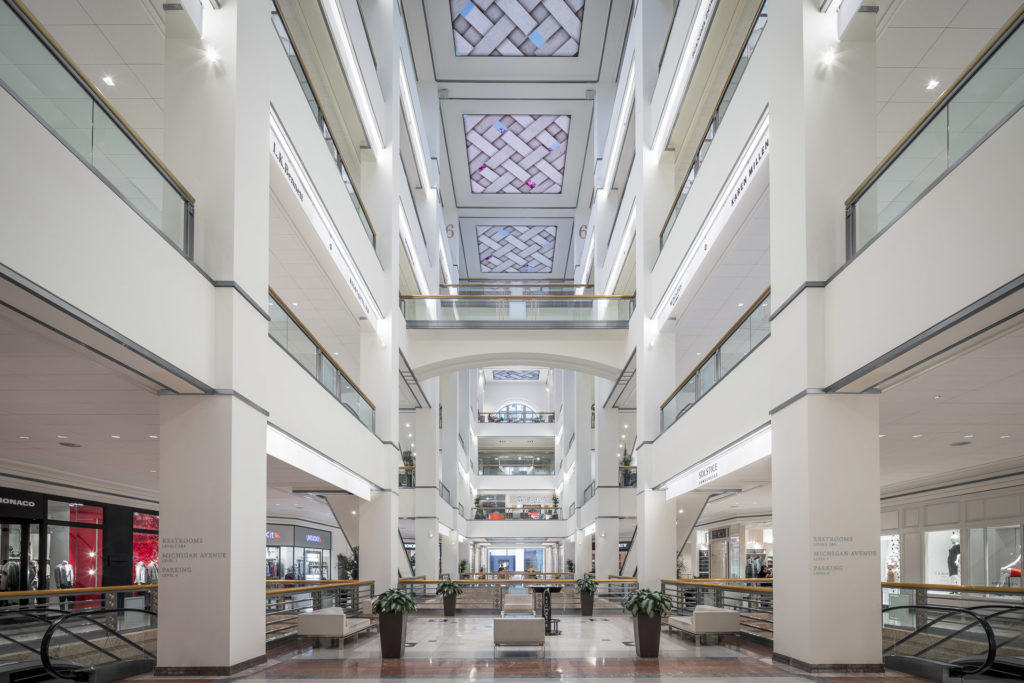Podcast: Epic-Scale Digital Signage Refreshes High-End Chicago Mall
Posted March 2, 2020
In a live case study discussion, that is now a Digital Signage Stories podcast episode, designer & A/V Technologist Andrew Lazarow shared how the ESI Design team used digital signage to modernize 900 North Michigan Shops. Recorded on-stage at Digital Signage Expo, Andrew was in conversation with Digital Signage Stories host Alesia Hendley.
Listen to the full Digital Signage Stories podcast here.
As 900 North Michigan Shops in Chicago approached their 30th birthday, they wanted to renew and celebrate their luster as an upscale retail destination. Using epic-scale digital signage, ESI Design worked with client JMB Realty Corporation to re-establish the mall’s identity as a luxurious retail center. ESI Design created a breathtaking 190-foot digital ceiling for the mall, which is visible from every floor as the largest and most intensive portion of the project.

Andrew explained that the ESI Design team also helped create light-up blade signs on every floor of the mall to facilitate wayfinding, two “teaser” screens on the mall’s exterior to advertise the mall’s digitally-focused experience to passersby, and a bronze entry portal with LED backlighting to drive home the 900 North Michigan shops’ new identity as a contemporary retail destination.
The digital ceiling was developed with a shopper’s experience in mind. Andrew told the audience at DSE that the mall is known for being home to high-end retailers. The ESI Design team worked to create digital signage that would embrace this indulgent shopping experience, especially for customers who have just made a purchase.
Listen to the full Digital Signage Stories podcast here.
Andrew explained that as storytellers, the experience design team did not think it would be right to bombard customers with advertisements on the screens. Instead, they opted to display peaceful custom content on the digital ceiling for shoppers to experience as they leave a store.
“We’re storytellers. Every good story has a beginning, middle, and an end. The beginning matters to draw you in, but it’s the ending that you remember most as you walk away,” Andrew said. “We wanted you to feel that uplift instantly as soon as you walk out of the store.”

In line with its commitment to providing long-term value to clients, ESI Design expertly calculated the best way to install the ten 20 by 20 foot screens that make up the digital ceiling. Andrew explained that the team chose a four-millimeter LED pitch as opposed to a pricier, higher resolution two-millimeter pitch to avoid unnecessary costs for the client.
“We took into account what would read at viewing distance as high resolution without actually having to make the screens a higher resolution than they needed to be,” Andrew said.
Listen to the full Digital Signage Stories podcast here.
In the event that the screens need servicing, the client can use the convenient hydraulic lift installed behind each panel to expose the LED hardware and make as-needed repairs. However, as Andrew pointed out, ESI Design seeks to proactively address issues that may arise with digital signage.
“This is not our first rodeo, so we know all of the foreseeable ways things can go wrong, and we have found ways to plan for that,” he said.

Part of planning ahead is what Andrew refers to as a “double redundancy.” The digital displays are backed up with “evergreen content,” a pre-rendered playlist in case something happens to the original content on the display.
“The screens are run on an uninterrupted power supply, so that even if power were cut to the building, our system would still be able to be running,” Andrew said. “Unless there was an epic power shortage that affected this part of Chicago, these screens would never go dark.”
Listen to the full Digital Signage Stories podcast here.
For Andrew and his team, the process is not over once digital signage is installed in a space. ESI Design installs monitors in each of its projects to ensure that the digital displays the firm creates are running smoothly.
“With every project, we put IP cameras with full views of the screen, so if anything is wrong, we usually flag it before the client even reaches out to us,” Andrew said. “We are constantly monitoring and getting feedback from both the hardware itself and from the actual visual feedback so we know what’s happening with our content.”


Join The Conversation